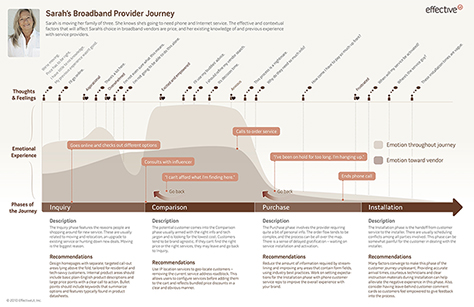What Are Customer Journey Maps?
Customer journey maps are documents that visually illustrate an individual customer’s needs, the series of interactions that are necessary to fulfill those needs, and the resulting emotional states a customer experiences throughout the process.
- need—what a customer has set out to achieve
- interactions—the necessary steps for a customer to satisfy those needs and achieve the overall goal
- emotions—the customer’s emotional state—including needs met, goals accomplished, and satisfaction level—before, during, and after the experience
By detailing a customer’s needs throughout an experience and revealing how each interaction negatively or positively impacts the customer’s emotional state, UX professionals can convert volumes of research findings and analysis into a concise, yet visually compelling story, which stakeholders across many levels of an organization can easily understand and interpret. Figure 1 shows an example of a customer journey map that illustrates a customer’s critical pain points.

What makes a customer journey map much more powerful than simply delivering personas and scenarios is its ability to highlight the flow of the customer experience—from the ups and downs along the way to those critical pain points where our attention and focus are most essential. While personas and scenarios put a face to a name and can deliver vivid narratives that communicate a customer’s overall needs, journey maps break a customer’s experience down into individual interactions, making the needs and emotions easier to recognize and more digestible.
Bruce Temkin, the author of the popular blog Customer Experience Matters,![]() supports this viewpoint, adding:
supports this viewpoint, adding:
“With internal and external research in hand, journey-mapping leaders need to distill their findings about how customers interact with the company, what they want from each interaction, and how they feel about each interaction today—the three key elements of a journey map.” [1]
By showing how customers feel throughout their journey, customer journey maps invite stakeholders to enter the world of customers and share in their experience. In turn, stakeholders are better able to convey their story to management, fellow colleagues, and the teams who are responsible for improving the service and product experience.
The Value of Customer Journey Maps Takes Flight
What do you do when you have to communicate research findings and analysis to hundreds of stakeholders across multiple disciplines?
I was fortunate to have the opportunity to explore this very question when my team of researchers and designers embarked on our own journey to help Boeing Commercial Aviation Services—the services arm of Boeing’s commercial airplanes division—evaluate the current customer experience for their flagship product, MyBoeingFleet.
Over the last 10 years, MyBoeingFleet has allowed customers to view detailed maintenance data and purchase replacement parts for their fleet of Boeing aircraft. This information-rich portal has become a trusted source of data and is integral to airlines’ operations. Although MyBoeingFleet was innovative for its time, Boeing began to realize that the ways in which it connected customers to information and supported specific individual workflows merited investigation.
Because Boeing’s reach is vast, our team of researchers met with and observed Boeing customers around the globe, interviewing more than 150 people across ten cities worldwide. Needless to say, the amount of data we collected forced our team to find the most effective way to disseminate our findings and recommendations. Although we wrote an extensive report and developed personas and scenarios as part of that effort, it wasn’t until we tried presenting information in customer journey maps that we found a format that could quickly, yet effectively convey the experience of customers.

